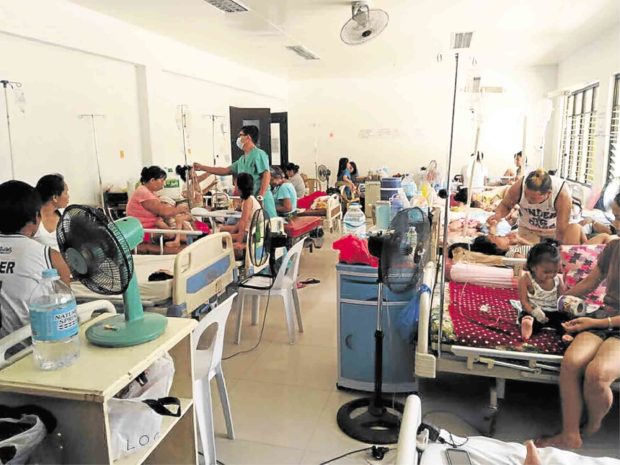
DENGUE WARD A ward at Eastern Samar Provincial Hospital in Borongan City is full of dengue patients and their families. On Monday, the provincial board of Eastern Samar declared the province under a state of calamity due to the rising number of dengue cases. —PHOTO COURTESY OF PHILIPPINE INFORMATION AGENCY
Dengue cases across the country continue to increase as the Department of Health (DOH) recorded more than 8,000 new cases in a span of a week.
The latest monitoring of the DOH Epidemiology Bureau showed 8,295 new dengue cases from July 7 to July 13. The figure is 53 percent higher compared to the 5,423 cases recorded during the same period last year.
More than 130,000 dengue cases, with 561 deaths, had been reported in the country from Jan. 1 to July 13. Cases of the mosquito-borne disease have nearly doubled this year, as only 67,690 cases and 367 deaths were recorded in 2018.
The DOH this month issued a national dengue alert amid the sharp increase in the number of cases in the country.
More than 29,000 of patients this year were children between 5 and 9 years old, DOH records showed.
Western Visayas region posted the highest number of dengue cases at 18,943 with 95 deaths.
Health Undersecretary Rolando Enrique Domingo said dengue cases usually increased during the rainy season, from July to September.
State of calamity
The dengue virus is transmitted through bites by the Aedes aegypti mosquito. The infection triggers a flu-like illness often followed by a severe drop in an infected person’s platelet count.
Eastern Samar is the latest province placed under a state of calamity due to the rising cases of dengue.
The provincial board issued the declaration during a special session on Monday based on the recommendation of the Provincial Disaster Risk Reduction and Management Office (PDRRMO).
Eastern Samar Gov. Ben Evardone said the provincial government would use its quick response fund to buy medicines and fogging machines.
Josefina Titong, PDRRMO chief, said the number of dengue cases in the province had already reached epidemic threshold with 1,012 cases as of July 23.
Of this, 257 dengue cases were reported in the last three weeks, she said. The provincial health office also recorded nine deaths since January.
Eastern Samar is the second province in Eastern Visayas, after Leyte, to declare a state of calamity due to dengue.
Jaime Opinion, Tacloban City health officer, said the city’s training center was converted into an emergency center due to the rising number of cases in the city. As of July 26, Tacloban had recorded 750 dengue cases with eight deaths.
Hot spots
The DOH said other regions with high dengue cases were Calabarzon (14,588 cases, 54 deaths), Zamboanga Peninsula (10,893 cases, 56 deaths), Northern Mindanao (10,393 cases, 28 deaths) and Soccsksargen (10,356 cases, 47 deaths).
These regions, along with Mimaropa, Bicol, Eastern Visayas and the Bangsamoro Autonomous Region in Muslim Mindanao, have already crossed the epidemic threshold. It means that the recorded cases in these areas have breached their average number of cases over the last five years, the DOH said.
In Bicol, the number of dengue fatalities in the region rose to 37.
The DOH Regional Epidemiology Surveillance Unit recorded 3,631 cases in Bicol this year.
Dr. Ernie Vera, DOH regional director, said although dengue cases in the region had reached an alarming level, the number had yet to breach the threshold level that would lead to the declaration of an outbreak.
“So far what we get are only sporadic cases,” he said.
Among the dengue hot spots in the region, where dengue cases were recorded in a four-week period, were 30 villages in Camarines Sur province, 14 in Sorsogon province, 12 in Albay province, seven in Catanduanes province and five in Masbate.
Protection
In Zamboanga Sibugay, Gov. Wilter Palma ordered school officials to require teachers and students to wear pants, long-sleeved shirts or blouses, leggings and knee-high socks during school days and school-sponsored activities to protect themselves from mosquito bites.
Palma, in an executive order, said requiring students to wear protective clothes was necessary since most dengue patients in the province were children. The governor also suspended the wearing of prescribed school uniforms in all schools in the province.
Zamboanga Sibugay was placed under a state of calamity on July 16 to allow the provincial government to use its quick response fund to address the dengue outbreak.
Records showed that at least 15 dengue patients, eight of them children, had died in Zamboanga Sibugay this year. The number of cases from January to July reached 3,566, up from only 150 cases recorded during the same period last year.